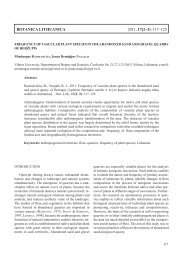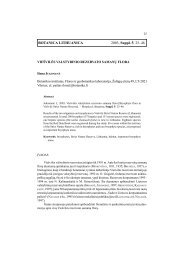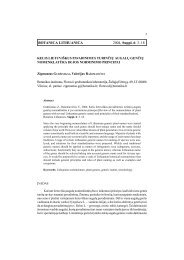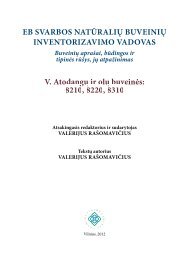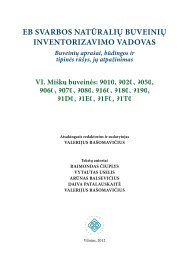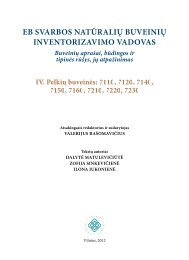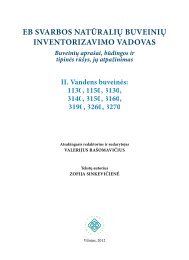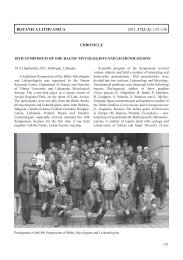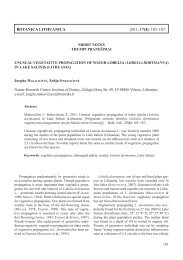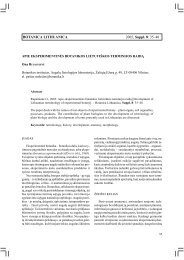FUNGI AND LICHENS IN THE BALTICS AND BEYOND XVIII ...
FUNGI AND LICHENS IN THE BALTICS AND BEYOND XVIII ...
FUNGI AND LICHENS IN THE BALTICS AND BEYOND XVIII ...
Create successful ePaper yourself
Turn your PDF publications into a flip-book with our unique Google optimized e-Paper software.
ecorded from the European streams, rivers, and lakes, of them c. 50 species are obligate<br />
freshwater lichens.<br />
In summer 2010, epilithic lichens were collected from 25 streams and rivers in<br />
Estonia. In addition, background data including habitat (e.g. openness, stoniness, current),<br />
water (pH, conductivity, total content of nitrogen and phosphorus) and stone characteristics<br />
(limestone vs granite, size and position in river) were collected.<br />
In total, 35 species were found; of these 14 belong to the group of obligate freshwater<br />
lichens. Three species – Verrucaria aquatilis, V. hydrela, V. praetermissa – have been found<br />
in most of the studied streams and rivers. Dermatocapon luridum, previously reported from<br />
five streams, was not recorded during the search.<br />
DIVERSITY OF EPIPHYTIC <strong>LICHENS</strong> <strong>AND</strong> AIR POLLUTION <strong>IN</strong> <strong>THE</strong> TOWN OF<br />
KAUNAS (CENTRAL LITHUANIA)<br />
G. SUJETOVIENĖ<br />
Vytautas Magnus University, Vileikos Str. 8, LT-44404 Kaunas, Lithuania<br />
E-mail: g.sujetoviene@gmf.vdu.lt<br />
The results of a biomonitoring study carried out in the town of Kaunas (central<br />
Lithuania) using the diversity of epiphytic lichens as bioindicators of air pollution are<br />
reported. The relationship between different features of lichen communities and<br />
environmental variables was investigated. The lowest air quality was found to be in the centre<br />
of the town – in the part of the study area where the traffic was more intense. The lowest<br />
index of lichen diversity (ILD) was found in the urban centre also. NO 2 concentration was the<br />
significant variable; it correlated positively with the proportion of nitrophyte lichen cover and<br />
negatively with the total lichen cover. It was concluded that the main source of air pollution in<br />
the area was from the motorized traffic and lichen diversity was largely determined by<br />
nitrogen dioxide. By calculating the index of atmospheric purity (IAP), three zones were<br />
established with different air pollution levels (a “poor air quality zone”, a “medium air quality<br />
zone”, and a “good air quality zone”). The species Xanthoria parietina, Physcia tenella,<br />
Parmelia sulcata, Lecanora chlarotera, Hypocenomyce scalaris were found to be the most<br />
tolerant.<br />
PRESENTATION OF <strong>THE</strong> NORDIC LICHEN FLORA IV – PARMELIACEAE<br />
A. <strong>THE</strong>LL 1 , R. MOBERG 2<br />
1 Lund University, Botanical Museum, Östra Vallgatan 18, SE-22361 Lund, Sweden<br />
2 Uppsala University, Museum of Evolution, Norrbyvägen 16, SE-752 36 Uppsala, Sweden<br />
E-mails: arne.Thell@biol.lu.se, roland.moberg@em.uu.se<br />
Until recently the largest macrolichen family, the Parmeliaceae, was regarded to<br />
contain three larger genera, Parmelia, including foliose species with laminal fruiting bodies,<br />
Cetraria, erect foliose species with marginal fruiting bodies, and Usnea, beard-lichens, the<br />
largest of the fruticose genera. Since the middle of the 20th century, these large genera have<br />
been divided into smaller entities on the basis of thallus morphology, but gradually more<br />
attention was paid to cortex anatomy, secondary chemistry and reproductive structures, and<br />
more recently to phylogeny based on DNA sequences. The Parmeliaceae comprises about<br />
2300 species and 80 genera in the world, i.e., almost one sixth of all the known lichens. The



